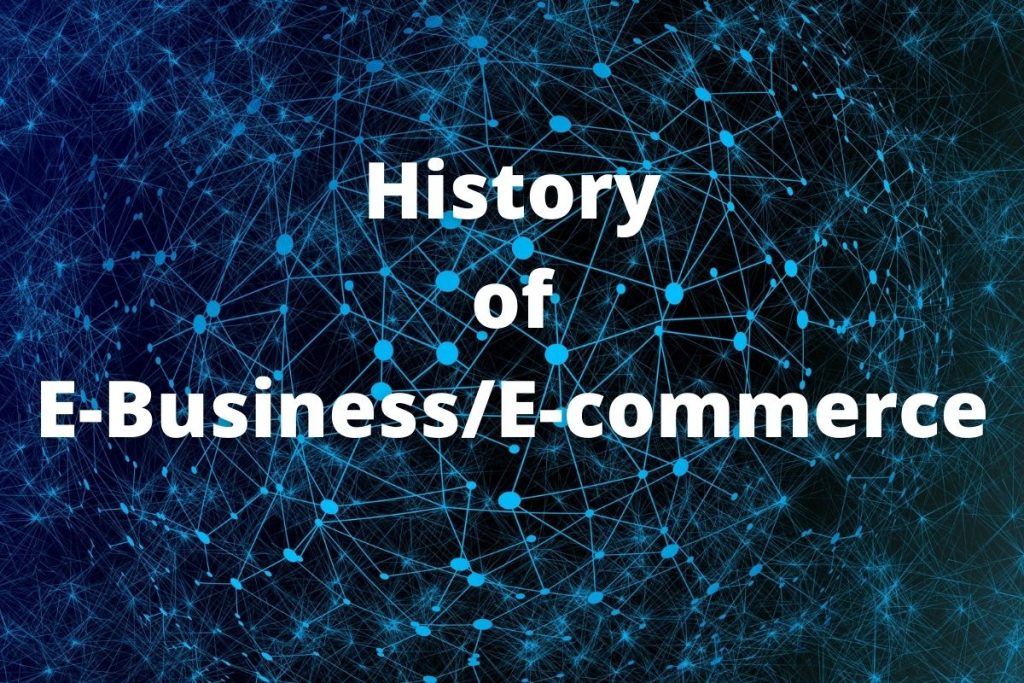What is history of eBusiness/eCommerce

History of E-Business/E-commerce
In history, the evolution of e-business (electronic business) is found in the early 1900s as simple, when text-based websites offered product information. For the first time internet was made available for commercial purposes. Websites were allowed to use the internet for business transactions. In history, the evolution of e-commerce (electronic commerce) can be founded in 1969 when the first e-commerce company CompuServe, USA was established.
Since then the evolution of e-commerce took place.
Here, we will understand the history/evolution of e-business and e-commerce from the beginning to today – how they are going.

1960’s: CompuServe Founded/EDI was Discovered
Amidst the landmark events of 1969, the history of eCommerce in the USA – and the world – begins in Columbus, Ohio with the launch of CompuServe, the first eCommerce company. Because there’s no internet, the company provides computer sharing services to businesses by sending data through phone lines (known as Electronic Data Interchange, or EDI)
1976: Online Transaction Processing Introduced
As the nation celebrates its bicentennial, Atalla Technovation and Bunker Ramo Corporation introduce products designed for secure online transaction processing, intended for financial institutions.
1983: Electronic Commerce Acknowledged
California State Assembly holds its first hearing on “electronic commerce.” Testifying are CPUC, MCI Mail, Prodigy, CompuServe, Volcano Telephone, and Pacific Telesis. A year later, California’s Electronic Commerce Act would pass, imposing certain requirements on systems designed “to conduct the purchase of goods and services via a telecommunications network.”
1994: The First Secure Online Transaction is Made
A full ten years after the launch of the Electronic Mall, Netscape 1.0 was released. Featuring
a protocol called Secure Socket Layer (SSL), it keeps both the sending and receiving side of online transactions secure through encryption. A number of third-party credit card processing companies launched shortly after as the internet becomes a truly commercial medium.
1999: Global eCommerce reaches $150 Billion
Start-ups proliferate, with entrepreneurs being seduced by the get-rich-quick promise of the internet. Of course, the good times won’t last forever.
2000: The Dotcom Burst and Online Advertising
The bubble bursts with the NASDAQ falling 75% from March 2000 to October 2002,
erasing most of the gains made since the internet took off. Many online and technology
entities declare bankruptcy, including Webvan, an early grocery delivery service.
2005: eCommerce Made a Comeback
E-Commerce bounces back from the burst big time, and Cyber Monday (the Monday after Black Friday) is introduced to boost online holiday purchases. In addition, Amazon launches Amazon Prime, giving members free 2-day shipping within the United States and making expedited shipping a consumer expectation. Today, there are approximately 142 million Prime members in the United States.
2006: Online Shopping Platforms Increase
Shopify, as we know it today, is founded by Tobias Lütke, Daniel Weinand, and Scott Lake, making it easy for merchants to create online stores. Many other eCommerce platforms, such as Magento and BigCommerce, quickly enter the space and made a name for themselves.
2012: Food Shopping Goes Virtual
Though the aforementioned Webvan and other grocery delivery services failed or struggled in the past, food shopping finally finds its groove in 2012, with the founding of Instacart. Instacart sends shoppers to local stores to pick out groceries that consumers order online. Today, with advances in cold warehousing and delivery, online food shopping is big business.
2017: E-commerce Remains Unstoppable
As brick-and-mortar sales decline, global e-commerce transactions soar, generating $29.267 trillion, including $25.516 trillion for B2B transactions and $3.851 trillion for B2C sales.
2020: The COVID-19 Boost
The coronavirus pandemic forces many physical stores to close their doors, and lockdowns keep many citizens quarantined at home. To purchase essentials and combat boredom, people embrace online shopping.

